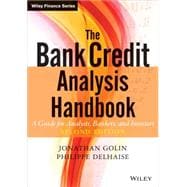
Note: Supplemental materials are not guaranteed with Rental or Used book purchases.
Purchase Benefits
What is included with this book?
JONATHAN GOLIN, a graduate of Berkeley and Harvard Law School, has more than fifteen years' experience in the financial sector. He worked at the Economist Intelligence Unit and as a credit analyst at Tokai Asia in Hong Kong before joining Thomson BankWatch Asia in 1997, a specialist rating agency. After BankWatch was absorbed by Fitch Ratings in 2000, Jonathan wrote the first edition of The Bank Credit Analysis Handbook (2002). Subsequently, he relocated to London and established his own bank credit research and training consultancy. Clients included Rabobank, Genworth Financial, Euromoney Training, the African Development Bank, and the Malaysia Deposit Insurance Corporation. More recently, Jonathan was employed by the UK's main bank regulator, the Financial Services Authority (FSA) as a risk specialist. Other books in which he had a lead role include Capital Flows Along the Mekong: The Complete Guide to Investing in Cambodia, Laos, Myanmar, and Vietnam (1995) and Covered Bonds beyond Pfandbriefe: Innovations, Investment and Structured Alternatives (2006).
PHILIPPE DELHAISE, PhD, is the founder of Capital Information Services and the Carbon Management Consulting Group. He was the President of the Asia Division of Thomson BankWatch, and served as an adjunct professor of finance at City University of Hong Kong. Philippe Delhaise is a graduate of the University of Louvain (Belgium), with degrees in engineering, philosophy, and economics, and a graduate of the University of Chicago Booth School of Business. He is currently the President of CTRisks Rating, a licensed rating agency in Hong Kong. In 1998, Wiley published Delhaise's well-received book on the 1997 banking crisis in Asia: Asia in Crisis: The Implosion of the Banking and Finance Systems.
|
|||
|
|||
|
|||
|
|||
|
|||
|
|||
|
|||
|
|||
|
|||
|
|||
|
|||
|
|||
|
|||
|
|||
|
|||
|
|||
|
|||
|
|||
|
|||
|
|||
|
|||
|
|||
|
|||
|
|||
|
|||
The New copy of this book will include any supplemental materials advertised. Please check the title of the book to determine if it should include any access cards, study guides, lab manuals, CDs, etc.
The Used, Rental and eBook copies of this book are not guaranteed to include any supplemental materials. Typically, only the book itself is included. This is true even if the title states it includes any access cards, study guides, lab manuals, CDs, etc.